The History of Ice
Cream in New Zealand
By Chris Newey
1840 - 1890
The First Ice Cream?
The very early European settlers arriving in New Zealand would have known
of ice cream from "back home", and from books and newspapers
of the day. Recipes and methods would have been easily accessible -
all you needed was access to milk, sugar and ice.
Fresh milk and cream first became available in New Zealand with the introduction
of Durham (Shorthorn) dairy cows in 1814 by missionary Samuel
Marsden, his herd growing to 50 animals by 1823. Settlers soon
discovered that this new country had an ideal climate for growing grass,
and for dairying - cows could be grazed outdoors all year round.
Shorthorns were the favourite imported breed at first, hardy animals
that could haul wagons as well as provide milk and meat. By the 1860s
and '70s, Jerseys, Friesians and Ayrshires were being brought in for
their higher milk production.
Sugar, the second major ingredient, was readily available, imported from
Australia, Mauritius and the West Indies.
To make ice cream, first sugar is added to cream and/or milk, along with
any flavourings required. The mix is usually heated and stirred to properly
dissolve the ingredients, then it has to be cooled back down.
To freeze the mix, ice on its own is not cold enough, but by mixing salt
into the ice, temperatures below freezing can be achieved.
An American woman, Nancy M. Johnson, invented and patented the "Artificial
Freezer" in 1843, a hand-cranked metal ice cream freezer, similar
in concept to a butter churn, but sitting inside an outer container packed
with ice and salt as refrigerant.
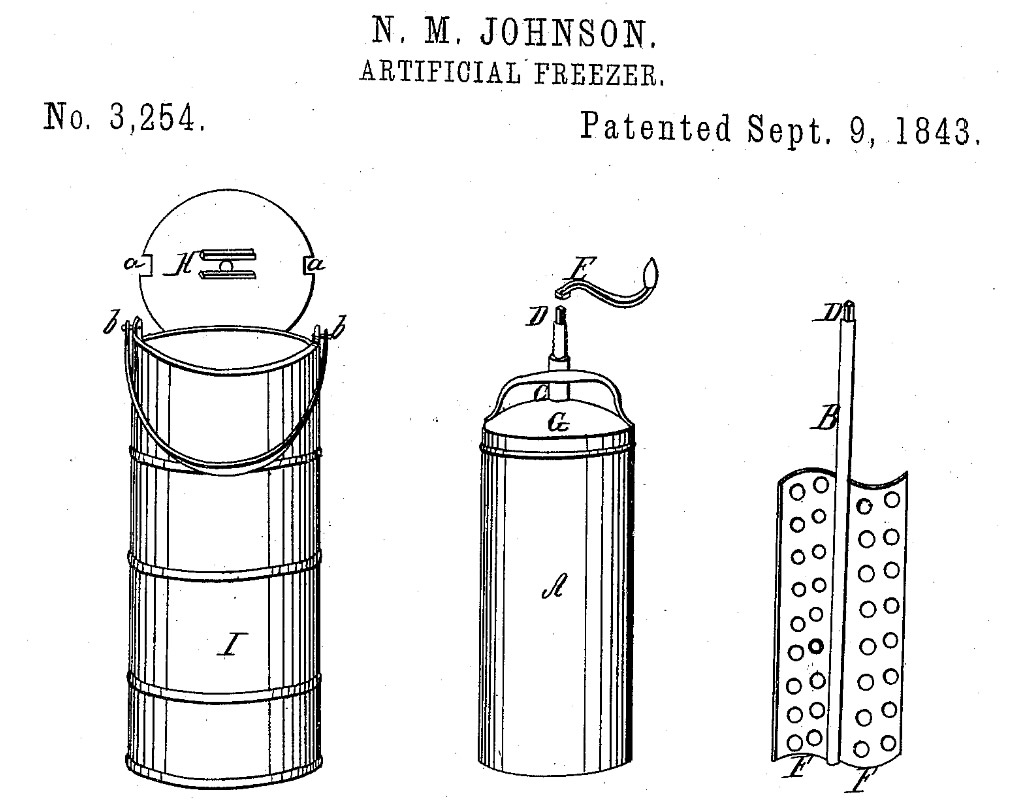
Patented Johnson Artificial Freezer.
- U.S. Patent and Trademark Office.

Patent Ice Cream Freezer.
- The Curious Kitchen.
The pre-cooled mix is placed in the central, vertical
cylindrical metal container, which sits inside an outer cylinder packed
with ice and salt, itself usually enclosed in wood for insulation.
A set of scraper blades on a vertical shaft is lowered into the mix and
a lid is placed over the top. The churn blades are rotated by hand crank,
scraping frozen mix from the inside walls of the metal container, and
whipping air into the mix at the same time.
Hand-cranked ice cream freezers such as these were available from the
late 1840s.
But in New Zealand, the ice would have been by far the most difficult
component to obtain.
Before the invention of mechanical refrigeration, ice cream making required
the collection, transport and storage of ice or snow from mountains,
glaciers, or from frozen lakes.
Luckily for our pioneering ice cream-makers, the commercial harvesting
of ice from frozen lakes in the New England area had turned into an international
business in the 1840s, lake ice being shipped from America, all around
the world.
Ice was packed in the holds of ships in large blocks, stacked together
tightly, with wood shavings, sawdust, or rice chaff packed around the
outside for insulation. By packing the blocks tightly, they behave as
a single large block of ice, significant melting occuring only on the
outside surfaces, and losses are kept to a minimum.
Special insulated ice houses were built to store the ice on arrival,
until it could be distributed. Ice boxes ("American refrigerators")
began to appear in the homes of the wealthy - wooden boxes lined with
tin or zinc and insulated with various materials including cork, sawdust,
and seaweed. A drip pan collected the melt water and had to be emptied
daily.
In 1855, Australian James Harrison patented the world's first refrigeration machine,
an ice-maker, which by 1859 was capable of producing five tons per day. By 1863
his machine
was said to be "in general use throughout Australia" so some mechanical
ice may
have
found
its
way across the Tasman.
In January 1859 shopkeeper and stockist of Schweppe's Soda Water, James Bentley
of
Bridge
St,
Nelson,
announced
the
arrival
of
a
shipment of ice, "the first importation of this most grateful luxury for
the
present
season, a continual supply of which has been arranged for" (Nelson
Examiner and New Zealand Chronicle, 26 January
1859). In the same newspaper, "Iced
Lemonade, Soda
Water, Ginger Beer" was advertised as available at the Star and Garter Hotel
in
Richmond.
In July 1862 "Strawberry Cream Ice", a frozen confection likely to
have
resembled
ice cream, was
listed
on
the
menu
for
a
public
dinner
to
commemorate
the opening of the Lyttelton & Christchurch Telegraph:

Lyttelton
Times, 12 July
1862
- PapersPast, via Steve Costello.
The 350 ton clipper barque "Constance" is reported to have brought a shipment
of ice to Auckland from Oregon in November 1863 (Press, 5
November 1863, via Dave Murray). The following month,"Cream and Water Ices"
were
on
the
menu
at
Mr Mann's
A 1 Hotel, on the corner of Cashel and Colombo Streets in Christchurch:

Press, 17 December 1863
- PapersPast, via Dave Murray.
Lake ice continued to be the most popular freezing medium.
Ice from Wenham
Lake in
Massachusetts, eighteen miles north-east of Boston, was harvested and
distributed
by the Wenham
Lake Ice Company, founded by Frederic Tudor, "The Ice King",
and became world-famous for its clarity and purity.
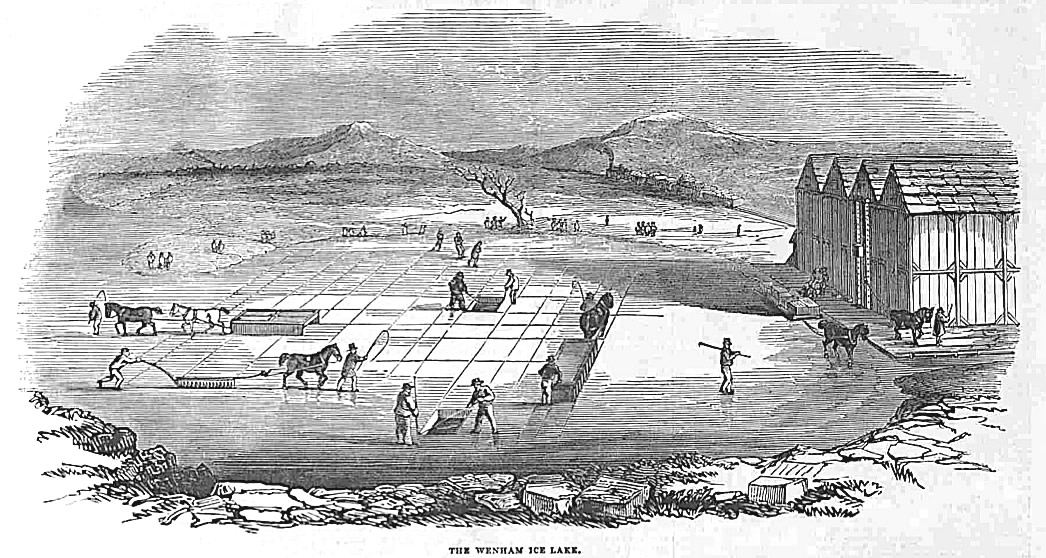
Wenham Lake ice harvesting, 1845
- Wikipedia.
And it is Wenham Ice that features in the earliest
advertisement we can find for the sale of "ice cream"
in this country.
On the 27th of January 1866, the following notice appeared
in the Wellington Independent newspaper:
ICE! ICE!! ICE!!!
AT THE EMPIRE HOTEL, WELLINGTON.
MR. JAMES OSGOOD has great pleasure in notifying his friends and the
public at large, that he has imported, at considerable expense, an article
never before introduced into Wellington, (to wit) LAKE WENHAM ICE. The
same will be in constant use at the EMPIRE until further notice.

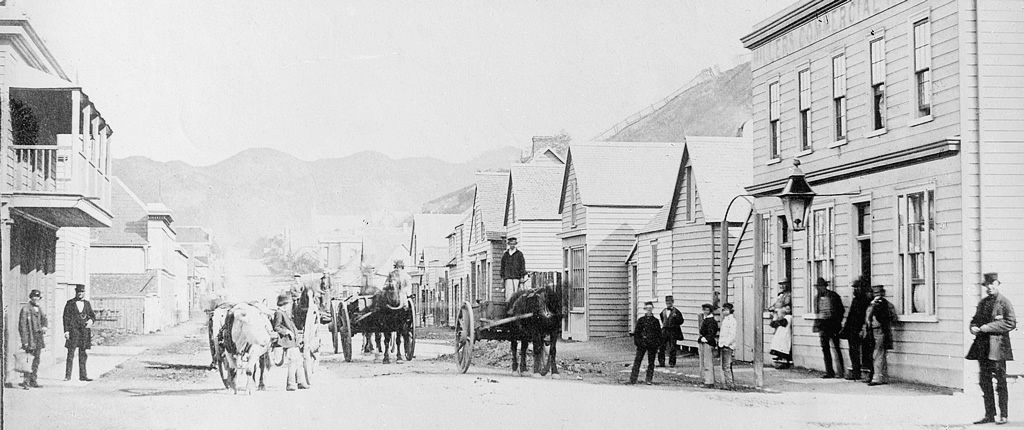
Mr James Osgood, second from left, outside The Empire Hotel,
Willis St, Wellington, 1861
- National
Library of NZ Ref: 1/1-017882-G.
The Ice Age
Local ice may have also been used.
In his opening address to the 1987 NZ Ice Cream Manufacturers' Association
annual conference, the Hon. Barry Dallas OBE, Mayor of Greymouth, referred
to the very first manufacture of ice cream taking place on the West Coast
of the South Island in 1867, in connection with the
pioneering exploration of the glaciers of the Southern Alps.
More research is required into this claim, as to whether it constituted
a business, or if it took place in anything resembling a factory.
So ice was by now easily available, but the arrival of industrial-scale
mechanical refrigeration in New Zealand in the early 1870s, and the supply
of cheaper, more
convenient "manufactured" or "factory" ice changed
everything.
Ice cream began to appear around the country:
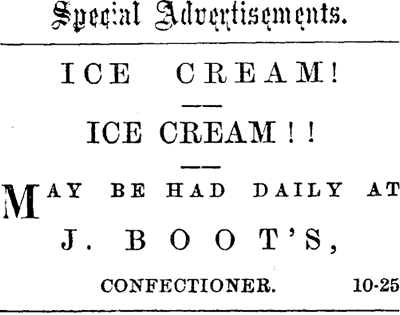
J. Boot's Confectioner (Christchurch) advertisement
for ice cream, The Press, 27 October 1870
By 1871, Mr George Gledhill was making
ice in his "Ice, Aerated Water, and Gingerbeer Factory" at
the corner of Albert and Wellesley Streets in Auckland. He used a Siebe
Brothers machine, based on James
Harrison's patent, using ether as the refrigerant.
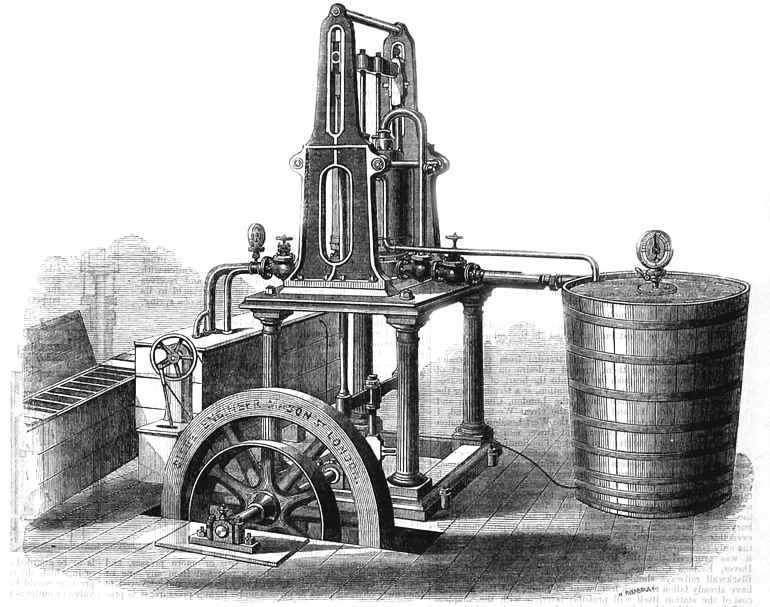
Harrison's ice-making machine, built by Siebe Brothers, London.
The first commercial refrigeration machine based on vapour compression.
- State Library of Victoria.
18 November 1875 - The earliest description that
we can find of an "ice cream manufacturer" in New Zealand
is this advertisement in Wellington's Evening Post:
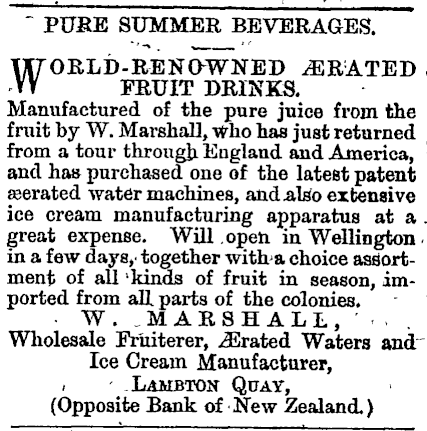
W. Marshall advertisement, Evening Post, 18 November 1875
In January 1878 Edward Hibberd, Ice Manufacturer of
Courtenay Place, Te Aro, Wellington was supplying "Hotels, Confectioners,
and the public generally, with Block Ice, or Ice Cream packed in Ice,
in any quantity".
Manufactured ice and ice cream came to Christchurch in 1878:
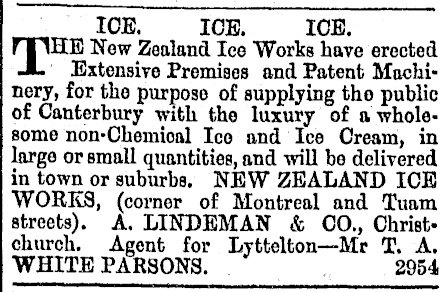
A. Lindeman & Co. advertisement, Star, 4 December 1878
Perhaps it was a bad summer, or perhaps the cost of setting up the
new venture was just too much - four months later, Adolph Lindeman's
business was bankrupted. The clearance sale listed some of his equipment:
" Ice safe, ice tubs, Ice cream machine, tubs and tins, 2 ice cream trucks,
3 bags salt, Almond nuts, walnuts, Barcelona nuts, Snow confectionery glasses,
cordials, &c."
The invention of the soda fountain and the ice cream soda in America
had led to soda fountain shops becoming fashonable around the
world.
Ornate American-style marble soda fountains were appearing all around
New Zealand, dispensing cordial-based cold drinks, often alongside ice
cream, sold and served in "Ice Cream Parlors" or "Saloons".
In those times, careful distinctions had to be made between these "unintoxicating" new
drinks and the evils of liquor.
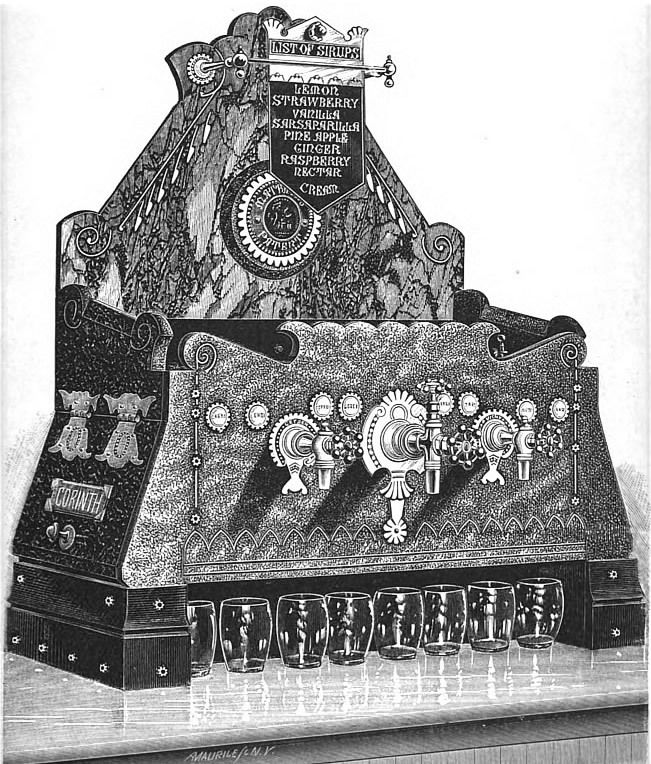
Soda fountain, Corinth brand, 1882.
- Atlas Obscura.
|